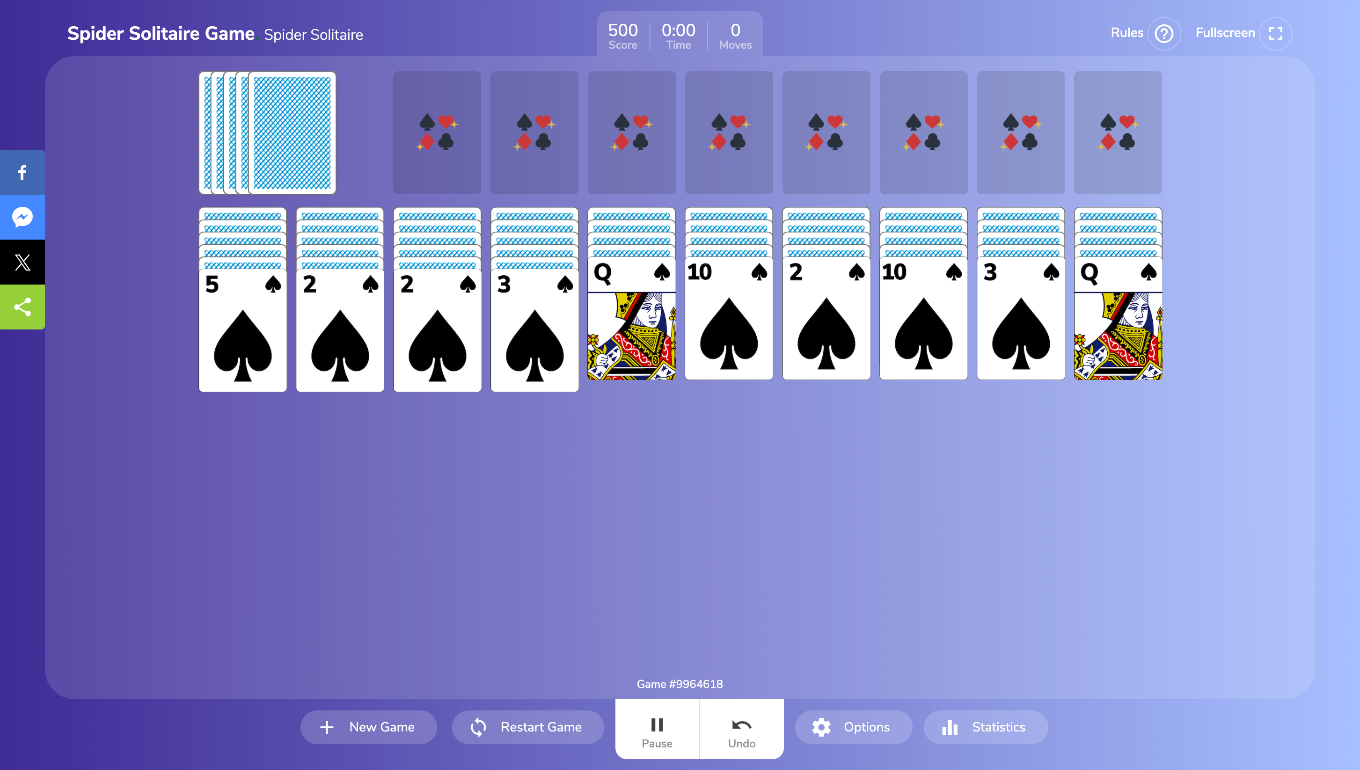SPIDER SOLITAIRE GAME
Game Introduction
Spider Solitaire Game stands as one of the most beloved and challenging card games in the digital age. This captivating two-deck solitaire variant has enchanted millions of players worldwide since its creation. According to Wikipedia, Spider Solitaire originated in 1949, and its intriguing name derives from a spider's eight legs, symbolizing the eight foundation piles that players must complete to achieve victory.
Unlike traditional solitaire games, Spider Solitaire Game offers a unique blend of strategy, patience, and skill that keeps players engaged for hours. The game's popularity skyrocketed when Microsoft included it in Windows 98, making it accessible to computer users everywhere. Today, you can play this timeless classic online, free, and with no download required, making it more convenient than ever to enjoy unlimited gaming sessions.
How to Play Solitaire (Spider)?
Game Setup and Objective
Spider Solitaire Game uses two standard decks totaling 104 cards, featuring all four suits: ♠️ Spades, ♥️ Hearts, ♦️ Diamonds, and ♣️ Clubs. The game begins with 54 cards dealt into ten tableau columns, with the first four columns containing six cards each and the remaining six columns holding five cards each. Only the top card in each column starts face-up, while all others remain face-down.
Your primary objective is to build eight complete sequences from King down to Ace, each consisting of the same suit. When you successfully create a complete sequence (K♠️-Q♠️-J♠️-10♠️-9♠️-8♠️-7♠️-6♠️-5♠️-4♠️-3♠️-2♠️-A♠️), it automatically moves to one of the eight foundation piles.
Card Movement Rules
Basic Movement: You can place any card onto another card that is one rank higher, regardless of suit. For example, you can place a 7♥️ on an 8♠️, or a Queen♦️ on a King♣️. This flexibility allows you to create temporary sequences while working toward your ultimate goal.
Same-Suit Sequences: The real strategy emerges when building same-suit sequences. Cards of the same suit in descending order can be moved together as a unit. For instance, if you have 9♠️-8♠️-7♠️ in sequence, you can move all three cards simultaneously to a 10 of any suit.
Empty Columns: When you clear a column completely, you can place any card or valid sequence in that empty space. This creates powerful strategic opportunities for reorganizing your tableau.
Stock Pile Usage: The remaining 50 cards form the stock pile. When you exhaust all possible moves in the tableau, you can deal ten new cards (one to each column) from the stock. However, you cannot deal new cards if any column is empty – all columns must contain at least one card.
Winning the Game
Victory comes when all eight foundation piles are filled with complete King-to-Ace sequences of the same suit. The game offers three difficulty levels: one suit (easiest), two suits (medium), and four suits (most challenging). In one-suit games, all cards are treated as the same suit, while four-suit games require managing all ♠️ ♥️ ♦️ ♣️ suits simultaneously.
Winning Tips and Quirky Tricks
Strategic Fundamentals
Prioritize Revealing Hidden Cards: Always focus on uncovering face-down cards before dealing from the stock pile. Each revealed card opens new strategic possibilities and prevents you from painting yourself into a corner.
Build Same-Suit Sequences: While you can stack different suits temporarily, prioritize building same-suit sequences whenever possible. These sequences move as units, providing crucial flexibility for complex maneuvers.
Manage Empty Columns Wisely: Empty columns are precious resources. Use them strategically to store high-value cards or complete sequences while you work on other areas of the tableau. Don't fill empty columns hastily with low-ranking cards.
Advanced Techniques
The Undo Button Strategy: Don't hesitate to use the undo feature extensively. Spider Solitaire often presents 50-50 situations where the correct choice isn't immediately apparent. Experimenting with different moves and undoing unsuccessful attempts is a legitimate part of mastering the game.
Stock Pile Timing: Resist the urge to deal new cards too quickly. Sometimes a few more moves in the current tableau can create significantly better opportunities than immediately adding complexity with new cards.
Suit Separation: In multi-suit games, try to keep different suits separated in different columns when possible. This prevents cards from becoming "locked" beneath cards of different suits.
Common Pitfalls to Avoid
Avoid stacking different-suited cards unnecessarily, as this locks lower cards and reduces your flexibility. Don't deal from the stock pile when profitable moves remain in the tableau. Finally, resist the temptation to move cards simply because you can – every move should serve a strategic purpose.
About SPIDER-SOLITAIRE-GAME.CC
Experience the ultimate Spider Solitaire Game destination designed for both casual players and serious enthusiasts. Our platform offers completely free, unlimited gameplay with no download requirements, making it instantly accessible on any device with an internet connection.
Choose from three engaging difficulty levels: start with one-suit Spider for a relaxing experience, advance to two-suit for moderate challenge, or test your skills with the demanding four-suit variation. The intuitive interface features smooth card animations, helpful hint systems, and comprehensive statistics tracking to monitor your improvement over time.
Our online platform provides the authentic Spider Solitaire experience you remember, enhanced with modern features like auto-save functionality, customizable backgrounds, and responsive design that works perfectly on desktop computers, tablets, and smartphones. Whether you have five minutes or five hours, you can enjoy seamless gameplay without registration hassles or annoying advertisements interrupting your concentration.
Join thousands of players who have discovered the perfect blend of strategy and relaxation that only Spider Solitaire can provide. Start your unlimited gaming journey today and rediscover why this classic card game has remained a favorite for over seven decades.
Ready to challenge yourself? Visit our platform now and start playing this timeless classic – completely free, online, and with unlimited gameplay that never gets old.

Frequently Asked Questions
-
How do you play Spider Solitaire?
Spider Solitaire is played with two decks of cards (104 cards). The goal is to build eight complete sequences from King to Ace in the same suit. Cards are arranged in 10 columns, and you can move cards in descending order. Only complete same-suit sequences can be moved to foundation piles to win.
-
What is the difference between 1, 2, and 4 suit Spider Solitaire?
1 Suit Spider uses only one suit (spades) and is the easiest. 2 Suit uses two colors (red and black) with medium difficulty. 4 Suit uses all four suits and is the most challenging. The difficulty increases because you need to match suits exactly for complete sequences.
-
Can you move multiple cards at once in Spider Solitaire?
Yes, you can move multiple cards as a group, but only if they are in descending order and of the same suit. Mixed-suit sequences cannot be moved together, even if they are in correct numerical order. This is a key strategy for revealing hidden cards.
-
When should you use the stockpile in Spider Solitaire?
Use the stockpile only as a last resort when no more moves are available in the tableau. Drawing from stock adds one card to each column, which can block existing sequences. Always exhaust all tableau moves before dealing new cards from the stockpile.
-
What is the best strategy to win Spider Solitaire?
Focus on building same-suit sequences first, reveal hidden cards by moving face-up cards, create empty columns when possible, and place higher-ranking cards in empty spaces. Avoid mixed-suit sequences unless necessary and plan moves carefully to avoid blocking important cards.
-
Is Spider Solitaire always winnable?
No, not all Spider Solitaire deals are winnable. Statistics show 1 Suit has about 52% win rate, 2 Suits around 17%, and 4 Suits only 6%. Some games are mathematically impossible to win due to card distribution, making strategy and skill crucial for winnable games.
-
Why is it called Spider Solitaire?
The game is called Spider Solitaire because spiders have eight legs, and the game requires building eight foundation piles to win. Each foundation represents one complete sequence from King to Ace, symbolically representing the spider's eight legs.
-
What cards can be placed on empty columns in Spider Solitaire?
Any card or sequence can be placed in an empty column, but Kings are recommended because they are the highest cards and allow for the longest possible sequences. Empty columns are valuable for temporarily storing cards and creating strategic moves.
-
Can you undo moves in Spider Solitaire?
In digital versions, unlimited undo is typically available and recommended for learning strategy. Using undo helps you experiment with different moves and understand consequences. Physical card games require manual backtracking, but the principle of reconsidering moves remains valuable.
-
How many decks of cards does Spider Solitaire use?
Spider Solitaire uses two standard 52-card decks without jokers, totaling 104 cards. The tableau starts with 54 cards dealt into 10 columns (4 columns with 6 cards, 6 columns with 5 cards), and 50 cards remain in the stockpile for later use.

